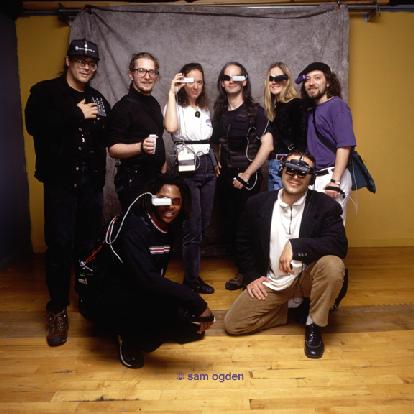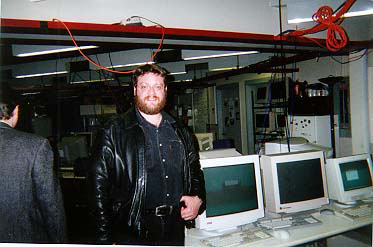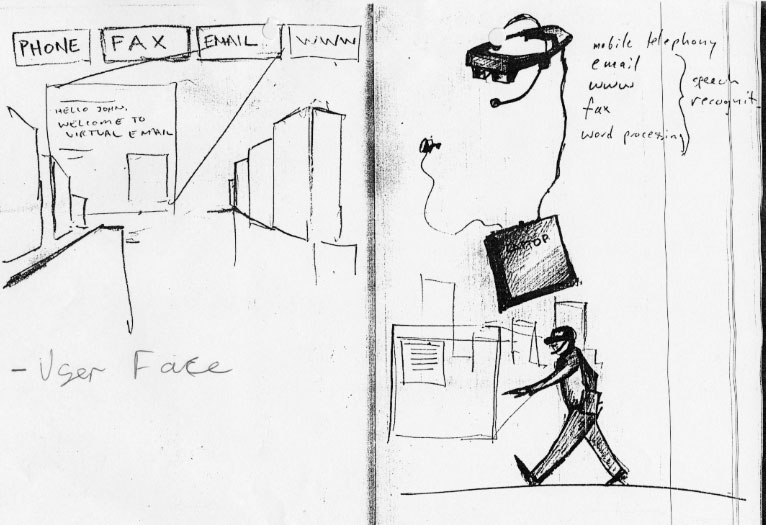Wearable Computers and Augmented
Reality
| My
First Introduction to Wearables
I was first introduced to the area of wearable computers when I visited the MIT Media Lab in Boston in 1995. This visit was by invitation of Mr William J Mitchell (dean of Architecture and Urban Planning at MIT) who had visited Melbourne and RMIT that year promoting his book 'City of Bits'.
I
met Steven Mann and Thad Starner on this visit at the Software Agents
Group section of the Media Lab. Both Mr Mann and Mr Starner had developed
different approaches to the idea of wearing the computer on the body.
Wearable
computers are small, usually hand assembled computers, powered by rechargeable
batteries. They are most often set up to deliver text-line interface
information to a head mounted display which the wearer uses for data
output instead of a monitor. Input to the computer is provided by a
chording keyboard, which enables the user to input commands single handedly.
Wearable
computer users are not immersed in a virtual reality, rather information augments the world around them, information appears superimposed
over the real world.
Wearable
computers and Augmented Reality offer ways to further examine the complex
inter-relationship between real and virtual space. These technologies
to a large extent invert the paradigm of representing space on a flat
screen, instead enabling information appear to permeate and interact
with physical space itself.
In 1998 I won a scholarship to formally attend the MIT Media Lab as a visiting scholar, and while there developed 3D signage which was designed to be used with Augmented Reality applications. I worked with Karrie Karahalios on the "Diorama" project. I was introduced to Karrie via Thad Starner, a key researcher in the field of wearable computers and augmented reality.
|
|
The
theme of EMU is the inter-relationship between urban space and electronically
mediated communities. The area of wearable computers ties in with this
broad theme, as these customised small portable and 'always-on' computers
enable the user to fully engage with the space around them and to annotate
that space with information pertinent to it, and while doing so, communicate
with other "Cyborgs" (as wearable computing aficionados refer
to themselves) via wireless local area network cards.

Wearable
computing researchers at MIT Media Lab circa 1997, second from
the left (standing) is Thad Starner who introduced me to Karrie Karahalios
with whom I collaborated on the Diorama project. Mr Starner also
provided me with key information which led to experiments in developing
a simple laptop based wearable computer at RMIT's "I Cubed"
facility in Melbourne . I am still continuing these experiments; using
a head mounted display with laptop computers and observing how this
type of computer usage differs from regular laptop use in terms of negotiating
urban space and discovering how computer use while in motion through
cities affects the types of media possible and desirable from the interplay
between being both online and in the 'real-world'.
In addition, experiments using wireless cameras for 'personal imaging' while drifting through urban space. The urban strechnology kit, developed by my partner Molly Hankwitz and I are directly linked to notions of mobile media usage as pursued by the wearable computing group at MIT.
Picture Courtesy
the Software Agents Group
MIT Media Lab
Cambridge, MA 02139 Taken
by Sam Ogden
|
|
|
Themes of Augmented Reality
There are inter-related themes which emerge when considering the possibilities of augmented reality - these have to do with the role played by media where digital content can be dynamic, reflecting changing aspects of the environment, or one's relationship to it.
Given that dynamic information pertinent to a specific geo-spatial location can be made available to users of wearable computers, the role of this information resembles that of conventional fixed signage (ads, traffic signs, billboards etc)
SIGNAGE
- symbols for navigation, information and instruction while online
and moving through urban environments
MIGRATION
- the constant moving from one place to another by the user of a wearable
computer means that the act of moving itself can be the basis for
certain types of digital media which are dynamic - an example is the
windmill which slows down and speeds up depending on the rate of data
traffic in Karrie
Karahalios' Diorama project. Although not a wearable computing
project, this application was an example of basic augmented reality.
SPACE - that geospatial area occupied by the user as s/he undertakes daily tasks while using the wearable computer. Terrain traversed, land covered, urban space negotiated. There are several types of space which augmented reality gives rise to, that of i) the information, that of ii) the environment, and a third type of space which is the iii) conceptual intersection of the physical, the informational and how they work together in the mind of the user.
DYNAMIC
MEDIA - media which update, refresh and present themselves in
the context of constantly shifting environmental conditions e.g. a
directional sign which constantly points to the way point desired.

Interview
with Thad Starner in his office at MIT Media Lab
Promotional video starring Alan Alda demonstrating a wearable computer with an augmented reality application.
|
|
|
|
|
|
|
|
|
|
|
Thad
Starner discusses in this video
sequence the range of applications wearable computers can make
possible.
Included
in this sequence is an impressive demonstration of a "sign-language
translation system" built into a baseball cap which 'reads'
the sign language gestures of the user and translates them rapidly
into spoken English. Power point slides also list the attributes
of wearable computers. The contents of these slides are here.
(4 minutes)
|
|
|
|
|
|
|
|
|
|
|
Wearable Computers
and EMU
I was first introduced
to wearable computers on my first visit to the MIT Media Lab in 1995.While there
I met Steve Mann and Thad Starner,both of whom were involved in developing computers
designed to be worn on the body, and connected via wireless network to others
likewise 'wired'.
Professor Steven Mann, a
pioneer and one of the guiding principles behind the wearable computer is a
major advocate of computer recycling – that is making use of obsolete
computers in order to turn them into devices that empower people against the
interests of the corporate mainstream. He strongly advocates the use of laptops
which otherwise would be thrown away as wearable computers, as well as such
devices as the eyepieces of video cameras as displays for wearable computers.
Much of his work revolves around exposing the one-way nature of corporate surveillance
for example, and his personal vision experiments are often also forms of agitational
propaganda, which seek to underscore the right of the individual to privacy,
to fair treatment at the hands of the law. He and his students often take part
in demonstrations in order to expose and record (in real time) evidence of police
brutality. He has gone on public record opposing the use of wearable computers
as part of for example, military uniforms. His stance is consistent with the
idea of social ecology – the creation of a climate of social exchange
amenable to the development of communities from the ‘ground-up’,
rather than the hierarchical/consumerist model on offer from most corners of
the global economy.
He is also an almost obsessive opponent of the reduction of public space as
a result of the influence of the retail sector in our contemporary cities. His
anti-corporate line is in stark contrast to the corporate vision of technological
determinism, which would only privilege the very latest technology, and only
that which can advance the creation of money. His politics got him into trouble
at MIT Media Lab, where many saw his use of personal imaging technology (i.e.
being online while streaming video of everything he saw) as a direct challenge
to the privatised notion of intellectual property as largely espoused by the
corporate backed lab itself.
I met Steve Mann at MIT Media Lab in 1995 and it was largely following my meeting
with him that I took an interest in the area of wearable computers, augmented
reality and related fields. I was very impressed by his humanitarian and largely
non-commercial worldview and his interest in adapting wearable computers in
order to aide the handicapped.
Perhaps though it is the coupling of notions of augmenting the world around
one with one’s own 3D signs with the theories of the Situationist International
which represent the greatest departure in my own philosophy from standard corporate
determinist thinking. The idea of the drift is to me inherently anti-capitalist.
The drift is about looking for ways to expose the central lie behind the corporate
claim on public space. By drifting around a city while wearing a wearable, a
person can transform their environment by informing themselves and others about
that environment. Wearables are often self-made (they can also be bought ‘off-the-shelf’)
and the fact that they are thus customised to match the requirements of the
user/hacker who made them means that they can be configured to suit the specific
needs of the person, or groups of people making use of them. This stands in
contrast to a model of wearable computer use which is characterised by what
Prof Steve Mann describes as
an 'office' model. Instead of having the wearable enable institutions to instruct
the wearer in specific specialised tasks, an 'existential computer' (a synonym
to Mann of his idea of the wearable)
There are thus forms of
technology of personal empowerment that directly defy the anti-environmental,
techno-determinist stance of big business. By empowering people with tools of
self-education such as wearable computers and related technologies people can
thus further understand the delicate nature of interconnected urban phenomena
and events in ways not prepared for them by those in power. The city is customisable,
sharable, open to interpretation, and thus by extension so is the social contract
itself.

David Cox at the MIT Media Lab 1998

Drawings
for Wearable Computer by David Cox, 1998
Fig 1 Signage Dynamic Media,
Migration and Signage Related aspects of media which are designed to be used
while the user simultaneously engaged with other activities
Augmented reality technologies
are a large part of modern warfare. In contrast to this model, Professor Steven
Mann has argued the case for a model of research based around the idea of ‘existential
computing’ which actively seeks to extend the capabilities of the user,
rather than enable a conduit for the influence of centralised institutions.
He argues the case for a type of approach to wearable computing and personal
imaging which actively resists the notion of computer as work device. It is
possible to consider the personal and community empowerment potentials of a
technology without the military overtones of that technology influencing aimed-for
progressive outcomes. The military applications of wearable technology tend
to stress telemetry and the tracking of troops in the field; the ‘smart
uniform’. This is very much a top-down hierarchical model, where the individual
is subordinated totally to the broader tactical and strategic demands of the
theatre of war and those that manage it.
More progressive applications emphasize the ‘existential’ aspect
of these technologies – their ability to modify and enhance the experience
for the person using them, and those they wish to collaborate with. Examples
of existential technologies, according to Steven Mann include the walkman, which
extended the enjoyment of music for a person into areas free of tethered ‘stereo’
equipment. The walkman would be difficult to frame in terms of obvious usefulness
to military applications. Personal wearable computers and augmented reality
technology should be seen more as descendents of the walkman and the wristwatch
than the command and control devices which the military would wish them to be
restricted to
.
But If the enemy is within -- within our own hearts, and within our collective
selves, we must equally consider questions like "What if terrorists infiltrated
positions of high authority or power?" and "How can we defend our
nation against terrorists operating from within the military?".
Prof
Steve Mann, C-Theory:
http://ctheory.net/text_file.asp?pick=368
EMU Signage



